On this episode of X10, Nicola describes how the best way to go about averting the overpopulation issue may be to make sure that women’s emancipation and child welfare get the attention they deserve.
Many of the things we said in this and previous overpopulation episodes on X10 were also summarized by Joe on It’s Okay to Be Smart; you might want to check it out!
Sources and Further Reading
Most data used in this episode is from Our World in Data (OWID).
- An overview of the fertility rate can be found on OWID here.
- The study on the effects of China’s one-child policy is: Feng, Wang, Yong Cai, and Baochang Gu. “Population, Policy, and Politics: How Will History Judge China’s One-Child Policy?.” Population and development review 38.s1 (2013): 115-129.
- Data on the relationship between women’s education, participation in the workforce, and the fertility rate are available in different subsections of OWID’s fertility rate entry. The studies from which OWID got the data:
- Becker, Sascha O., Francesco Cinnirella, and Ludger Woessmann. “The Trade-off between Fertility and Education: Evidence from before the Demographic Transition.” Journal of Economic Growth 15, no. 3 (September 1, 2010): 177–204. doi:10.1007/s10887-010-9054-x.
- Murtin, F. (2013). “Long-term determinants of the demographic transition, 1870–2000.” Review of Economics and Statistics, 95(2), 617–631.Duflo, E., Kremer, M., and Dupas, P. (2015).
- “Education, HIV, and early fertility: Experimental evidence from Kenya.” American Economic Review, Volume 105. No. 9: (pp. 2757-97).
- Chicoine, Luke (2012) – “Education and fertility: evidence from a policy change in Kenya.” IZA Discussion Paper Number 6778.
- Breierova, L., and Duflo, E. (2004). “The impact of education on fertility and child mortality: do fathers really matter less than mothers?” NBER Working Paper No.10513. (May 2004).
- Relationship between education and contraceptive use: Rosenzweig, M., and Schultz, T. P. (1989). “Schooling, information and nonmarket productivity: contraceptive use and its effectiveness.” International Economic Review, 30(2), 457–77.
- Unintended pregnancies in 2012 Sedgh, Gilda, Susheela Singh, and Rubina Hussain (2014) – “Intended and Unintended Pregnancies Worldwide in 2012 and Recent Trends.” Studies in family planning 45.3 (2014): 301–314. PMC. Web. 16 Oct. 2017. A note on this study from OWID: “Unplanned births include those occurring two or more years sooner than desired (“mistimed”) and those that were not wanted at all by the mother (“unwanted”). The source of information on the parents’ or women’s intention used by the authors are mostly surveys conducted in different countries and world regions.”
- Unintended pregnancies in 1990-2014 Bearak, J., Popinchalk, A., Alkema, L., & Sedgh, G. (2018). Global, regional, and subregional trends in unintended pregnancy and its outcomes from 1990 to 2014: estimates from a Bayesian hierarchical model. The Lancet Global Health, 6(4), e380-e389.
- The figures for births and deaths in 2012 are from this OWID chart that spans a much larger time period
- The breakdown of deaths by age in 2012 is again from OWID, available here
- Achievements of family planning in Iran are available on WHO’s website
- OWID’s entry on child labor is available here; a study on how child labor restriction impacted fertility rates is Döpke (2004) – Accounting for Fertility Decline During the Transition to Growth. Journal of Economic Growth. September 2004, Volume 9, Issue 3, pp 347–383. Available here.
- On the subject of child mortality and overpopulation, this video from Bill Gates further explains how saving lives reduces overpopulation.
- The study entry on how very high HDI may increase the fertility rate is: Myrskylä, M., Kohler, H. P., & Billari, F. C. (2009). Advances in development reverse fertility declines. Nature, 460(7256), 741-743.
- It’s also possible that secularization will further reduce fertility. There’s evidence suggesting that more religious populations have higher fertility rates, while more secular ones have lower fertility rates.
Script
In our previous overpopulation episode, we had a look at the various projections of human population growth published by the United Nations, and we saw that humanity isn’t set to grow exponentially forever. In fact, right now, it’s growing much more slowly than that, and this growth is gradually slowing down, to the point that our population might stabilize barely short of 11 billion people by 2100.
The UN projections don’t account for life extension, because it’s not a thing yet, and as we saw, making an accurate projection of the possible demographic consequences of life extension is very difficult. We settled down for two worst-case approximations that assumed that far, far fewer deaths than it’s reasonable to expect will take place over the course of this century; the result was a very high ceiling of somewhere between 17 and 22 billion people by 2100.
That sounds like a lot, and if we actually had that many people on the planet right now, we’d probably be in deep trouble. If we assumed that life extension might cause an increase like that, what could we do to prevent it?
Welcome to X10, your one-stop YouTube show for all things life extension. If this is your first rodeo, click the subscribe button to follow our channel! Don’t forget to click the bell icon and then “all notifications” to be notified whenever we publish a new episode.
If we predicted that life extension therapies might cause the human population to grow too large, we’d basically have two options to deal with that: finding a way to keep our numbers lower or increasing our ability to sustainably support a larger population.
Both options are feasible in principle, and they’re not mutually exclusive. In this episode, we’re going to focus on ways to counteract population growth; in the next one, we’ll talk about how science and technology may come to the rescue and save the day.
People’s first thought is often that, to make up for any population increase caused by life extension, we’d have to force people to have few or no children, like China’s one-child policy. That’s a way to reduce the fertility rate, but there are better ones that don’t involve coercion; in fact, there’s evidence that the Chinese one-child policy might not have been necessary in the first place.
A study found that, regardless of the policy, China’s fertility rate would probably have fallen regardless, following the same downwards trajectory it already was on before the one-policy was even implemented.
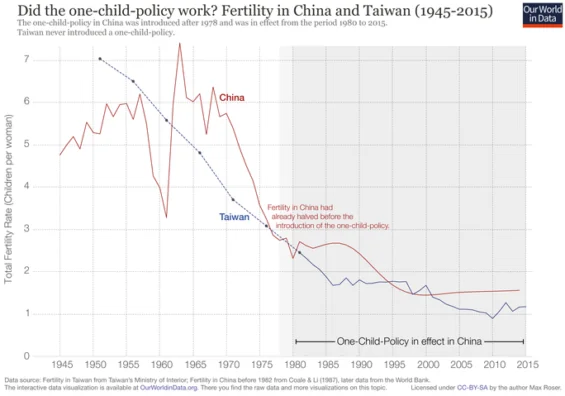
We know from the previous episode that the fertility rate of the world has been going down on its own for a while now, but what has been driving it down?
The main driver is, without an ounce of doubt, the empowerment of women across the globe, both in general and especially in terms of education and social status. The level of education attained by women is one of the best predictors of how many children they will have: the more educated they are, the fewer the children they’ll have.
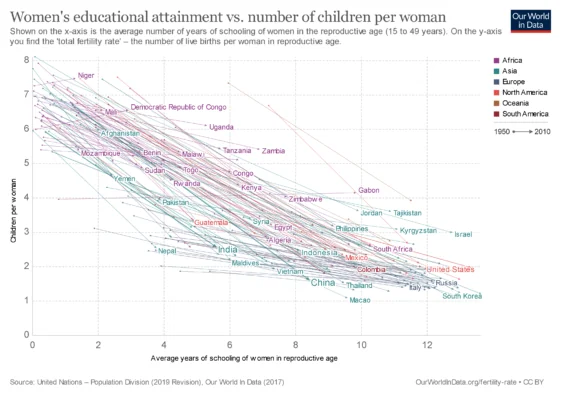
This is true in general but particularly, and somewhat surprisingly, in countries with traditionally high fertility rates.
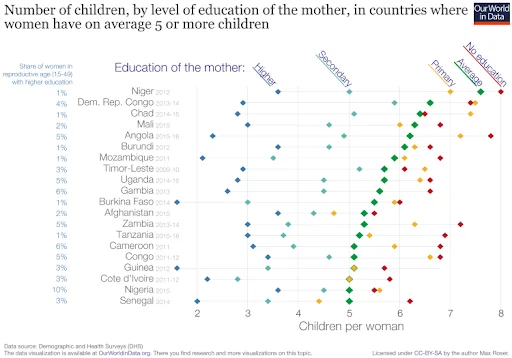
Higher education has a range of ripple effects that explain this phenomenon, the most evident being the increase in the opportunity costs involved in having children. Having kids is costly, both directly and indirectly.
Direct costs are financial: for example, schooling and childcare. Indirect costs are lost opportunities: it takes time and effort to carry out a pregnancy and to raise a child, and these things are done mostly or exclusively by women.
Life offers more opportunities beyond motherhood to a more educated woman, for whom more children mean more opportunities to turn down in favor of parenting. A less educated woman has fewer opportunities to begin with, so for her, making children comes at a lower opportunity cost. This pushes more educated women to want fewer children.
Education of women has also the effect of lowering child mortality: a better educated mother can take better care of her children, keep them in good health, and prevent their deaths at young ages. As we’re going to see in a moment, lower child mortality has the counterintuitive effect of reducing the fertility rate.
With better education also comes higher understanding of, acceptance of, and ability to effectively use contraceptives, which has the unsurprising effect of reducing births and thus the fertility rate.
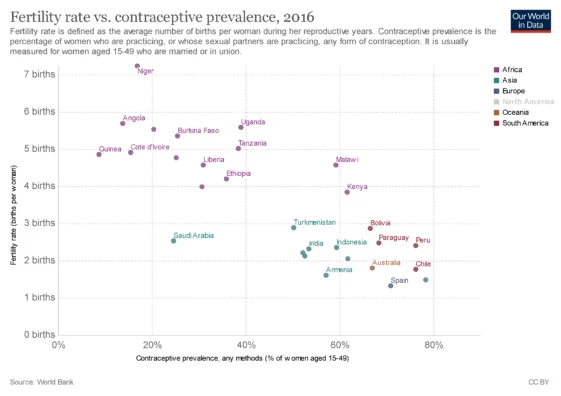
In this regard, there’s definitely room for improvement: the share of married women of reproductive age who don’t want children but don’t use contraceptives is fairly high: in many parts of the world, it’s above 20%.
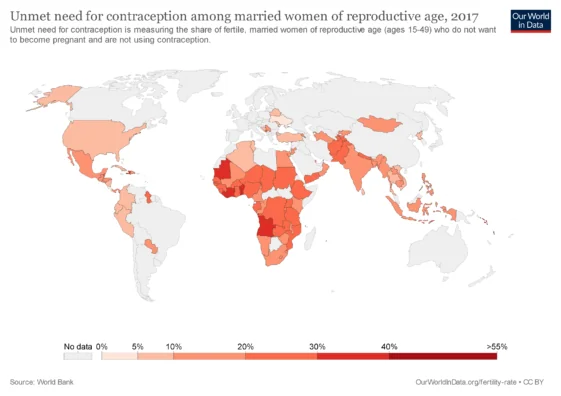
There’s evidence that, the larger the unmet need for contraception, the higher the fertility rate, which comes as no surprise at all.
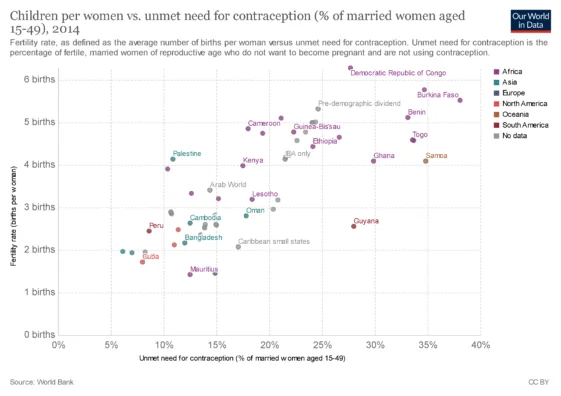
This is especially interesting when you consider that, in 2012, there were 213 million pregnancies all over the world, 85 million of which were estimated to be unwanted. That’s a good 40% of the pregnancies that year.
Fifty percent of the unwanted pregnancies were aborted, and 13% ended up in miscarriage, but 38% resulted in an unplanned birth. That’s a whopping 32 million babies that their mothers or families didn’t want, and they were almost 23% of all the 140 million babies born that year.
For comparison, about 55 million people died in 2012, of which slightly more than 25 million were aged 70 or above. On the fair enough assumption that most of them died of age-related causes, preventing the 32 million unwanted births of 2012 would have more than offset age-related deaths for that year.
2012 was no special case: the percentage of unwanted pregnancies around the world is going down, but it’s far from zero, which suggests a way to balance out, or at least mitigate, the potential population growth induced by life extension. Given that the size of the elderly population of the world will increase significantly during this century, this would probably not be a silver bullet, but it’s still something to keep in mind.
More widespread access to contraceptives can help prevent unwanted pregnancies, and so can family planning—that is, actively deciding how many kids a family wants, often with the help of a counselor. In Iran, the results of family planning were spectacular: they drove the fertility rate from 6.5 in 1982 down to less than two in 2003.
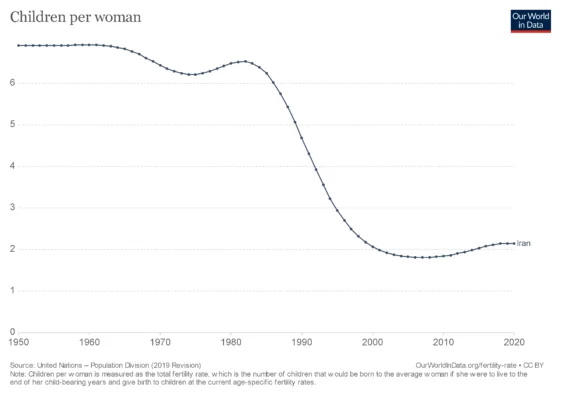
Education of women and in general also facilitates the change of social norms, and social norms can have a big impact on the number of children that parents desire. It’s also possible that the role models represented in the media can help pull the fertility rate down: for example, if the fictional women that real women see on TV all have jobs and small families, this can push their expectations for themselves away from more traditional models that depict women as just mothers and wives.
Education and fertility are linked in a positive feedback loop, in which more education drives fertility down, which drives education up. As women become more educated, they choose to have fewer kids; this, in turn, may reduce the size of the next generation, meaning that the school system can dedicate more resources to fewer children. The better educated children of today will be the better educated parents of tomorrow who will choose to have fewer children, and so on.
Just like education, the participation of women in the workforce has a similar fertility-reducing effect: for women who can and do work, the opportunity cost of children rises. Juggling kids and work is not easy, so more kids mean less time to dedicate to work and more work opportunities to turn down. Hence, working women tend to want fewer kids, which lowers the global fertility rate.
The relationship between women’s participation in the workforce and fertility works the other way around, too: the lower the fertility rate, the less that women are busy raising children and the more time they have to dedicate to work. The data is unequivocal that where the fertility rate is higher, the share of working women is lower.
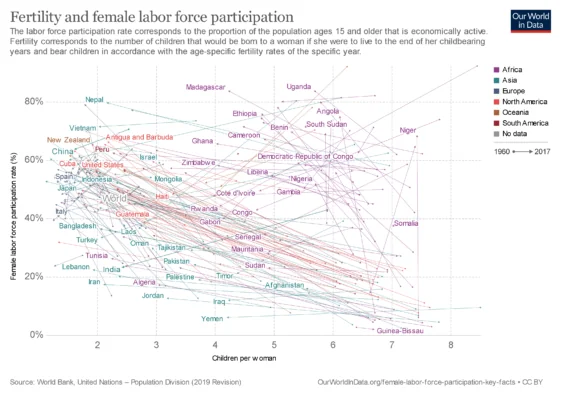
Long story short: if you’re concerned about overpopulation, be it because of life extension or in general, your best bet is to be an advocate for women’s empowerment in society. As women become more emancipated, the fertility rate drops dramatically, so that’s a great way to go about solving this issue, but it’s not the only one.
The global fertility rate also goes down as child well-being increases and child mortality rates drop. This may seem counterintuitive, because if more children survive, how does that not lead to a larger population?
This phenomenon is best understood from a historical perspective. In rural societies of the past, children were an economic asset for a family, an extra pair of hands that could do work and bring in more money.
Unfortunately, in the past, child mortality was very high, and parents who lost a child didn’t just go through a terrible emotional ordeal, they could also incur monetary losses because they lost a child and a worker.
That’s why child hoarding was a thing in the past. As the rather unpleasant name suggests, child hoarding was the practice of making more babies than were actually wanted to ensure the family against the probable loss of at least some of the children.
Child hoarding and the overall higher mortality rate of the past kept each other almost in check for a good part of our history, throughout which the growth rate of the human population was minimal but not zero.
As child mortality started to decline as a result of medicine, sanitation, and so on, hoarding was no longer needed and gradually disappeared too. This advancement didn’t happen right away, which was a contributing factor to the breakneck speed at which the human population grew during the 1900s, but it did help bring the fertility rate down.
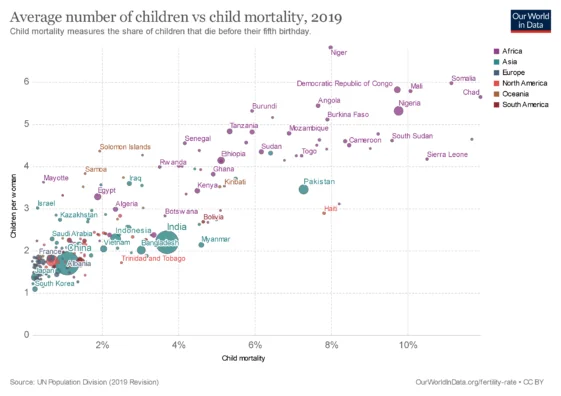
Additionally, most countries transitioned from a low-tech economy in which child labor was useful and encouraged to a high-tech economy in which child labor isn’t so useful and is very much frowned upon.
As restrictions on child labor tightened, child employment decreased significantly, and while this was great, from a strictly economic standpoint, it increased the opportunity cost of children. In other words, having more children meant more expenses and brought no economic benefits.
That’s when parents started preferring quality over quantity. While in the past, they invested fewer resources on more children, now they invest more resources on fewer children.
This behavior didn’t make much sense in rural societies with high child mortality, where investing too much on few children or a single child was like putting all your eggs in the same basket. In modern, low-mortality societies, this approach makes a lot of sense, because the odds are that all of a family’s children will survive to adulthood.
In short, low child mortality and higher child well-being are incentives to make fewer babies. They’re great things for their own sake and in their own right, and they also have the added benefit of lowering the fertility rate and containing population growth.
Working to reduce child mortality as much as possible and to protect the well-being of children are therefore great ways to counteract population growth and definitely more humane than letting older people die, but we’re gonna talk ethics in another episode.
The levels of health, education, living standards, and overall prosperity of a country is captured by a metric called the Human Development Index. As the global HDI goes up, the effects we discussed in this episode are amplified, and, as a result, the fertility rate goes down. The relationship between the HDI and the fertility rate is quite clear,
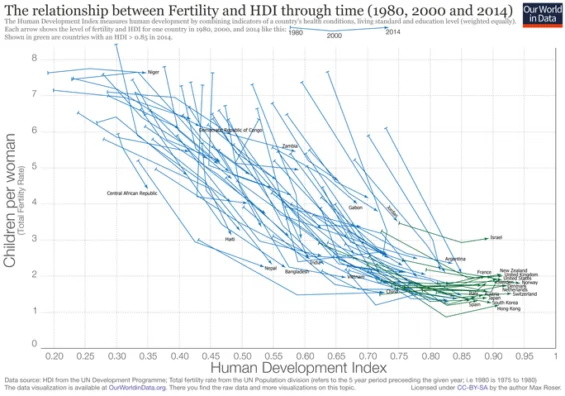
though there is evidence that, at very high HDI levels, fertility tends to go up, though not very much.
At this point, it’s unclear if there’s a causal link behind this trend reversal or not, but the study that discovered this association suggests that the slight increase in the fertility rate observed with high HDI levels might have the potential to slow down population aging. That may well be true, but let’s not forget that life extension has the potential to eliminate it altogether, and that’s a whole lot better.
Cutting on the fertility rate may be one way to curb population growth, but if that didn’t work out, would we have to give up on life extension? Maybe not. Science can help with that, as we’ll see in the next episode.
Thanks a bunch for watching this X10 episode, and thanks for liking, commenting, sharing, and subscribing. Speaking of which, if you want to subscribe, click the red button below, then click the bell icon and select “all notifications” to always be up to date with our videos.
If you like what we do and would like to help, consider joining the Lifespan Heroes. Their monthly donations allow X10 to keep going, and they also allow Lifespan.io to carry on its mission to crowdfund and advocate for life extension research. To become a Lifespan Hero, visit lifespan.io/hero. Other than that, see you next time! Take care.




